Software Project Team Roles and Responsibilities
VerifiedAdded on 2020/02/24
|21
|3386
|35
AI Summary
This document outlines the various roles and responsibilities within a software project team. It lists individuals responsible for different areas such as process modeling, requirement analysis, system design, GUI prototyping, implementation, testing, and client presentation. Each role is briefly described, providing a comprehensive overview of the team structure and individual contributions.
Contribute Materials
Your contribution can guide someone’s learning journey. Share your
documents today.
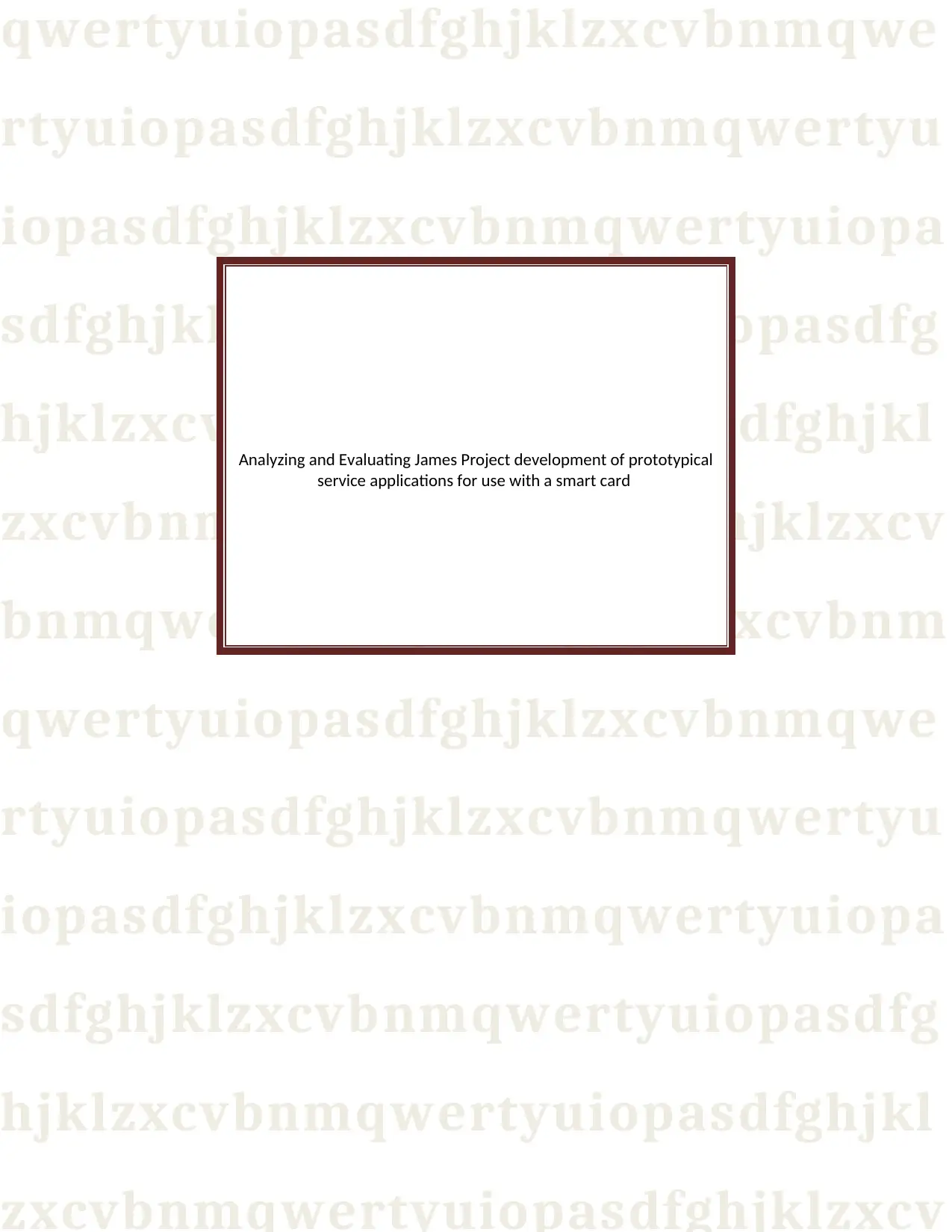
qwertyuiopasdfghjklzxcvbnmqwe
rtyuiopasdfghjklzxcvbnmqwertyu
iopasdfghjklzxcvbnmqwertyuiopa
sdfghjklzxcvbnmqwertyuiopasdfg
hjklzxcvbnmqwertyuiopasdfghjkl
zxcvbnmqwertyuiopasdfghjklzxcv
bnmqwertyuiopasdfghjklzxcvbnm
qwertyuiopasdfghjklzxcvbnmqwe
rtyuiopasdfghjklzxcvbnmqwertyu
iopasdfghjklzxcvbnmqwertyuiopa
sdfghjklzxcvbnmqwertyuiopasdfg
hjklzxcvbnmqwertyuiopasdfghjkl
zxcvbnmqwertyuiopasdfghjklzxcv
Analyzing and Evaluating James Project development of prototypical
service applications for use with a smart card
rtyuiopasdfghjklzxcvbnmqwertyu
iopasdfghjklzxcvbnmqwertyuiopa
sdfghjklzxcvbnmqwertyuiopasdfg
hjklzxcvbnmqwertyuiopasdfghjkl
zxcvbnmqwertyuiopasdfghjklzxcv
bnmqwertyuiopasdfghjklzxcvbnm
qwertyuiopasdfghjklzxcvbnmqwe
rtyuiopasdfghjklzxcvbnmqwertyu
iopasdfghjklzxcvbnmqwertyuiopa
sdfghjklzxcvbnmqwertyuiopasdfg
hjklzxcvbnmqwertyuiopasdfghjkl
zxcvbnmqwertyuiopasdfghjklzxcv
Analyzing and Evaluating James Project development of prototypical
service applications for use with a smart card
Secure Best Marks with AI Grader
Need help grading? Try our AI Grader for instant feedback on your assignments.
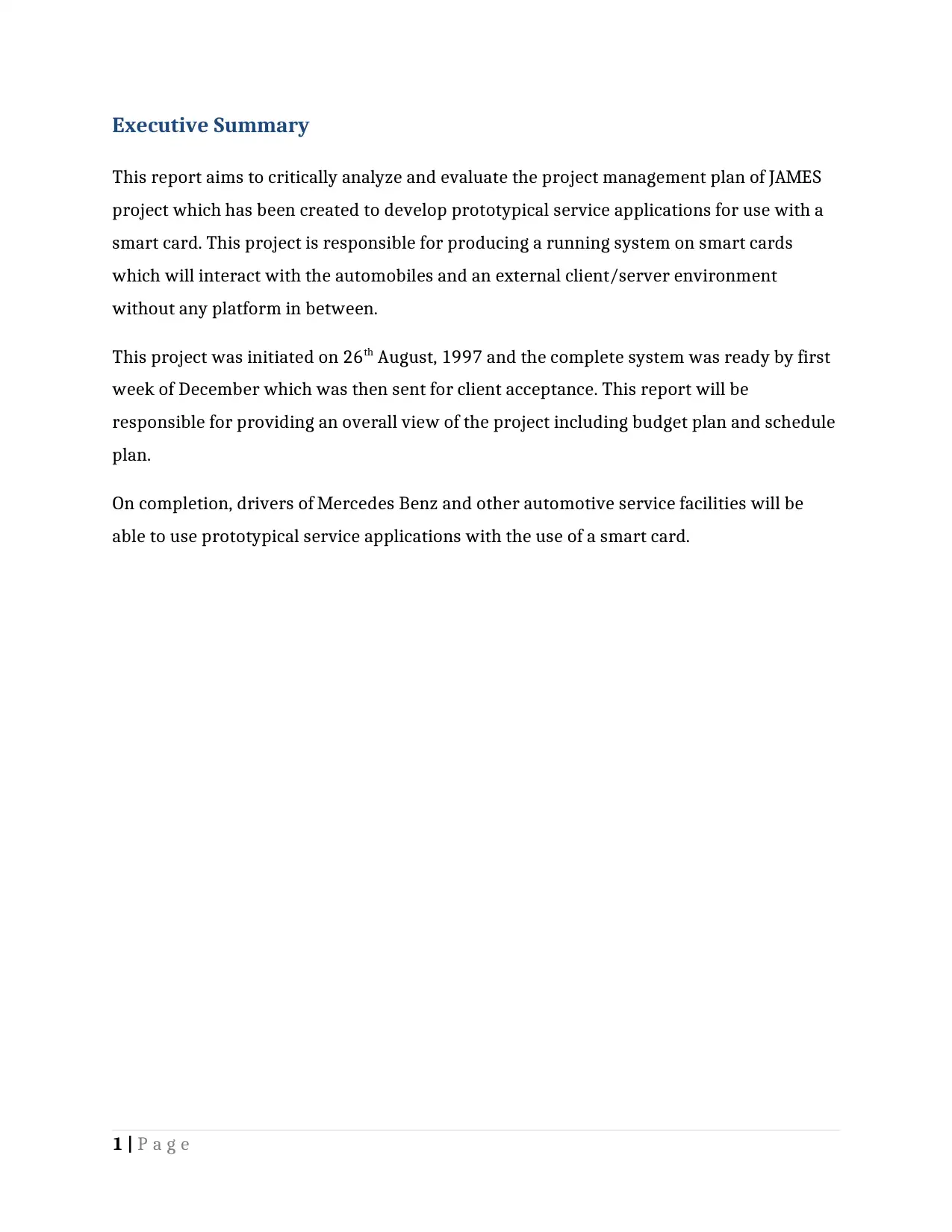
Executive Summary
This report aims to critically analyze and evaluate the project management plan of JAMES
project which has been created to develop prototypical service applications for use with a
smart card. This project is responsible for producing a running system on smart cards
which will interact with the automobiles and an external client/server environment
without any platform in between.
This project was initiated on 26th August, 1997 and the complete system was ready by first
week of December which was then sent for client acceptance. This report will be
responsible for providing an overall view of the project including budget plan and schedule
plan.
On completion, drivers of Mercedes Benz and other automotive service facilities will be
able to use prototypical service applications with the use of a smart card.
1 | P a g e
This report aims to critically analyze and evaluate the project management plan of JAMES
project which has been created to develop prototypical service applications for use with a
smart card. This project is responsible for producing a running system on smart cards
which will interact with the automobiles and an external client/server environment
without any platform in between.
This project was initiated on 26th August, 1997 and the complete system was ready by first
week of December which was then sent for client acceptance. This report will be
responsible for providing an overall view of the project including budget plan and schedule
plan.
On completion, drivers of Mercedes Benz and other automotive service facilities will be
able to use prototypical service applications with the use of a smart card.
1 | P a g e
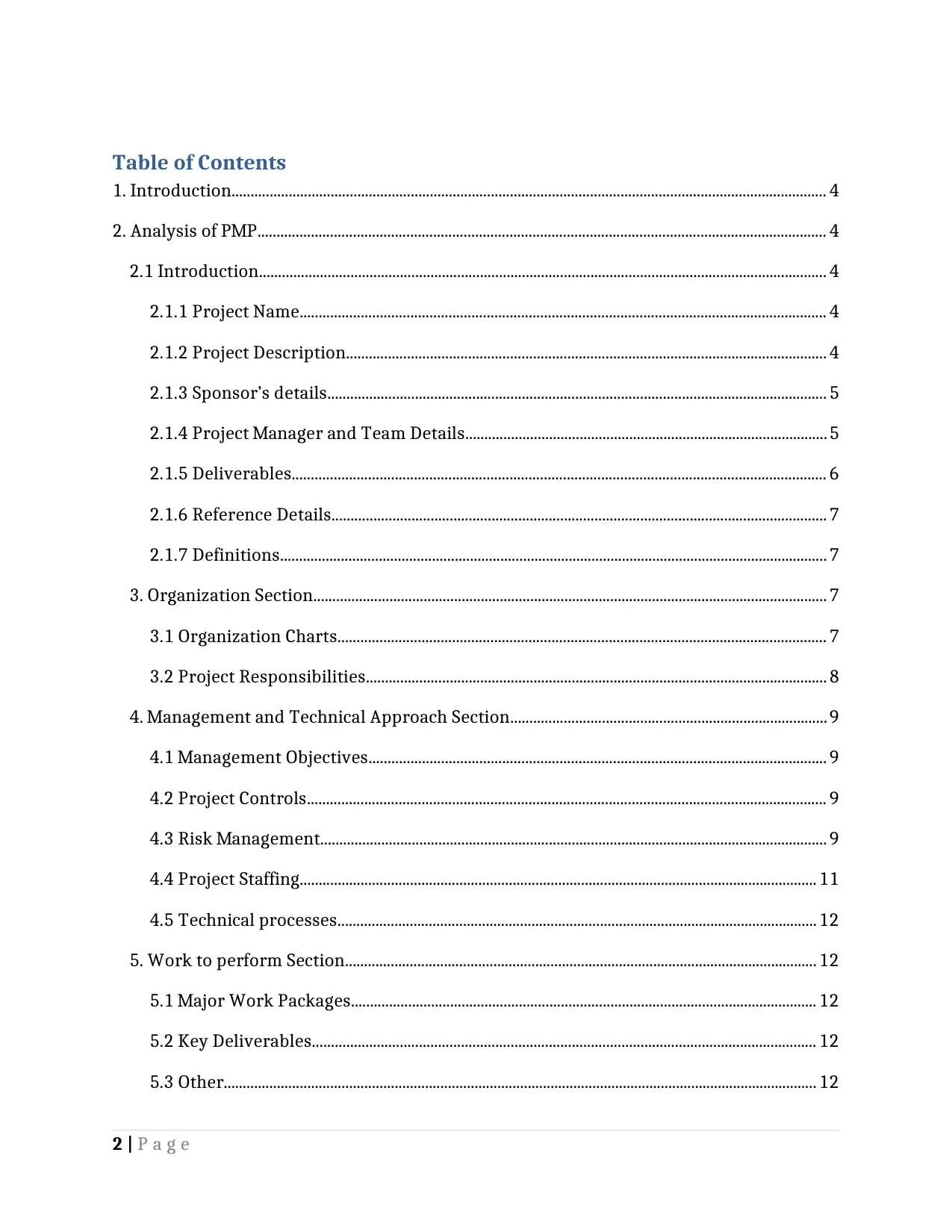
Table of Contents
1. Introduction............................................................................................................................................................ 4
2. Analysis of PMP..................................................................................................................................................... 4
2.1 Introduction..................................................................................................................................................... 4
2.1.1 Project Name.......................................................................................................................................... 4
2.1.2 Project Description.............................................................................................................................. 4
2.1.3 Sponsor’s details................................................................................................................................... 5
2.1.4 Project Manager and Team Details...............................................................................................5
2.1.5 Deliverables............................................................................................................................................ 6
2.1.6 Reference Details.................................................................................................................................. 7
2.1.7 Definitions................................................................................................................................................ 7
3. Organization Section....................................................................................................................................... 7
3.1 Organization Charts................................................................................................................................ 7
3.2 Project Responsibilities......................................................................................................................... 8
4. Management and Technical Approach Section...................................................................................9
4.1 Management Objectives........................................................................................................................ 9
4.2 Project Controls........................................................................................................................................ 9
4.3 Risk Management..................................................................................................................................... 9
4.4 Project Staffing........................................................................................................................................ 11
4.5 Technical processes..............................................................................................................................12
5. Work to perform Section............................................................................................................................12
5.1 Major Work Packages.......................................................................................................................... 12
5.2 Key Deliverables.................................................................................................................................... 12
5.3 Other............................................................................................................................................................ 12
2 | P a g e
1. Introduction............................................................................................................................................................ 4
2. Analysis of PMP..................................................................................................................................................... 4
2.1 Introduction..................................................................................................................................................... 4
2.1.1 Project Name.......................................................................................................................................... 4
2.1.2 Project Description.............................................................................................................................. 4
2.1.3 Sponsor’s details................................................................................................................................... 5
2.1.4 Project Manager and Team Details...............................................................................................5
2.1.5 Deliverables............................................................................................................................................ 6
2.1.6 Reference Details.................................................................................................................................. 7
2.1.7 Definitions................................................................................................................................................ 7
3. Organization Section....................................................................................................................................... 7
3.1 Organization Charts................................................................................................................................ 7
3.2 Project Responsibilities......................................................................................................................... 8
4. Management and Technical Approach Section...................................................................................9
4.1 Management Objectives........................................................................................................................ 9
4.2 Project Controls........................................................................................................................................ 9
4.3 Risk Management..................................................................................................................................... 9
4.4 Project Staffing........................................................................................................................................ 11
4.5 Technical processes..............................................................................................................................12
5. Work to perform Section............................................................................................................................12
5.1 Major Work Packages.......................................................................................................................... 12
5.2 Key Deliverables.................................................................................................................................... 12
5.3 Other............................................................................................................................................................ 12
2 | P a g e
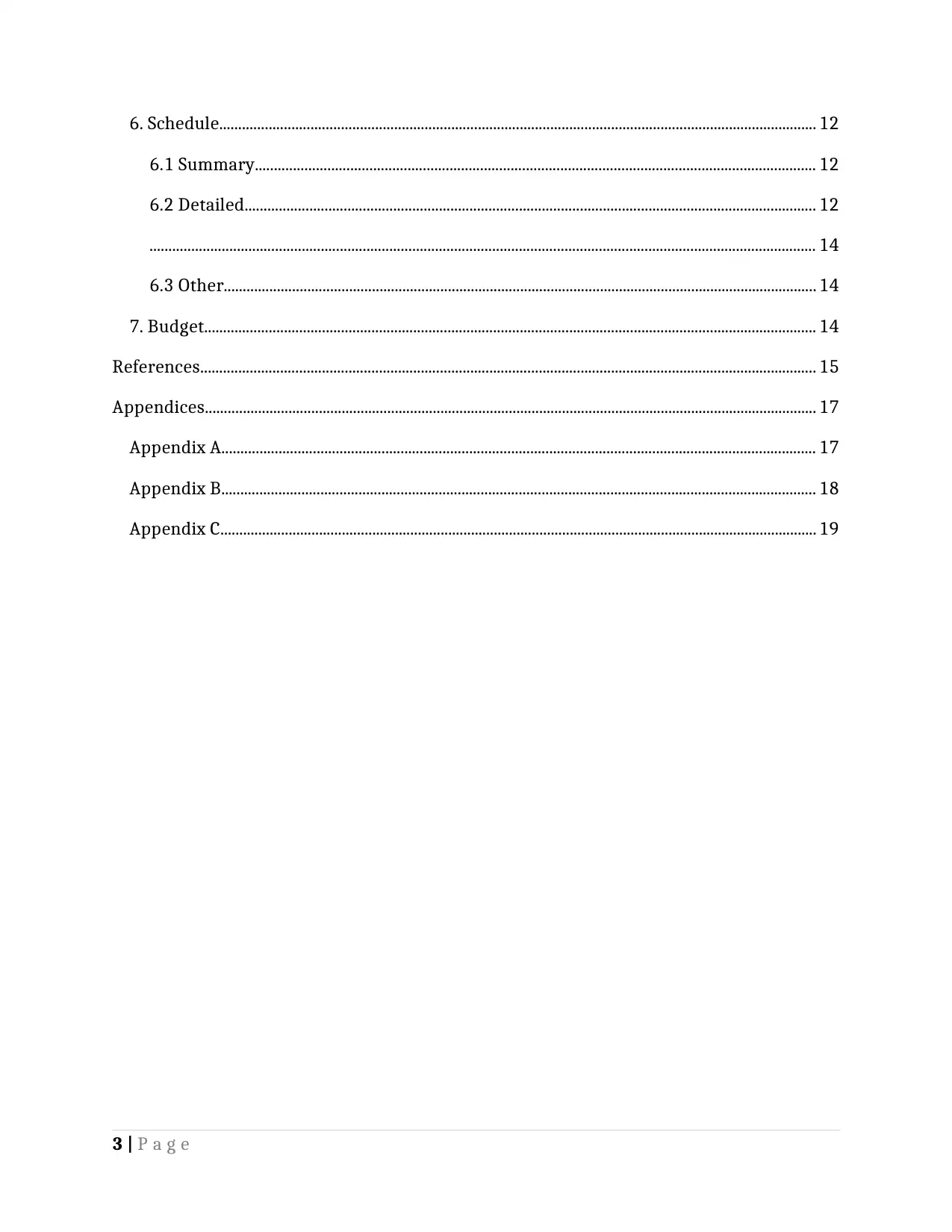
6. Schedule............................................................................................................................................................. 12
6.1 Summary................................................................................................................................................... 12
6.2 Detailed...................................................................................................................................................... 12
............................................................................................................................................................................... 14
6.3 Other............................................................................................................................................................ 14
7. Budget................................................................................................................................................................. 14
References.................................................................................................................................................................. 15
Appendices................................................................................................................................................................. 17
Appendix A............................................................................................................................................................ 17
Appendix B............................................................................................................................................................ 18
Appendix C............................................................................................................................................................. 19
3 | P a g e
6.1 Summary................................................................................................................................................... 12
6.2 Detailed...................................................................................................................................................... 12
............................................................................................................................................................................... 14
6.3 Other............................................................................................................................................................ 14
7. Budget................................................................................................................................................................. 14
References.................................................................................................................................................................. 15
Appendices................................................................................................................................................................. 17
Appendix A............................................................................................................................................................ 17
Appendix B............................................................................................................................................................ 18
Appendix C............................................................................................................................................................. 19
3 | P a g e
Secure Best Marks with AI Grader
Need help grading? Try our AI Grader for instant feedback on your assignments.
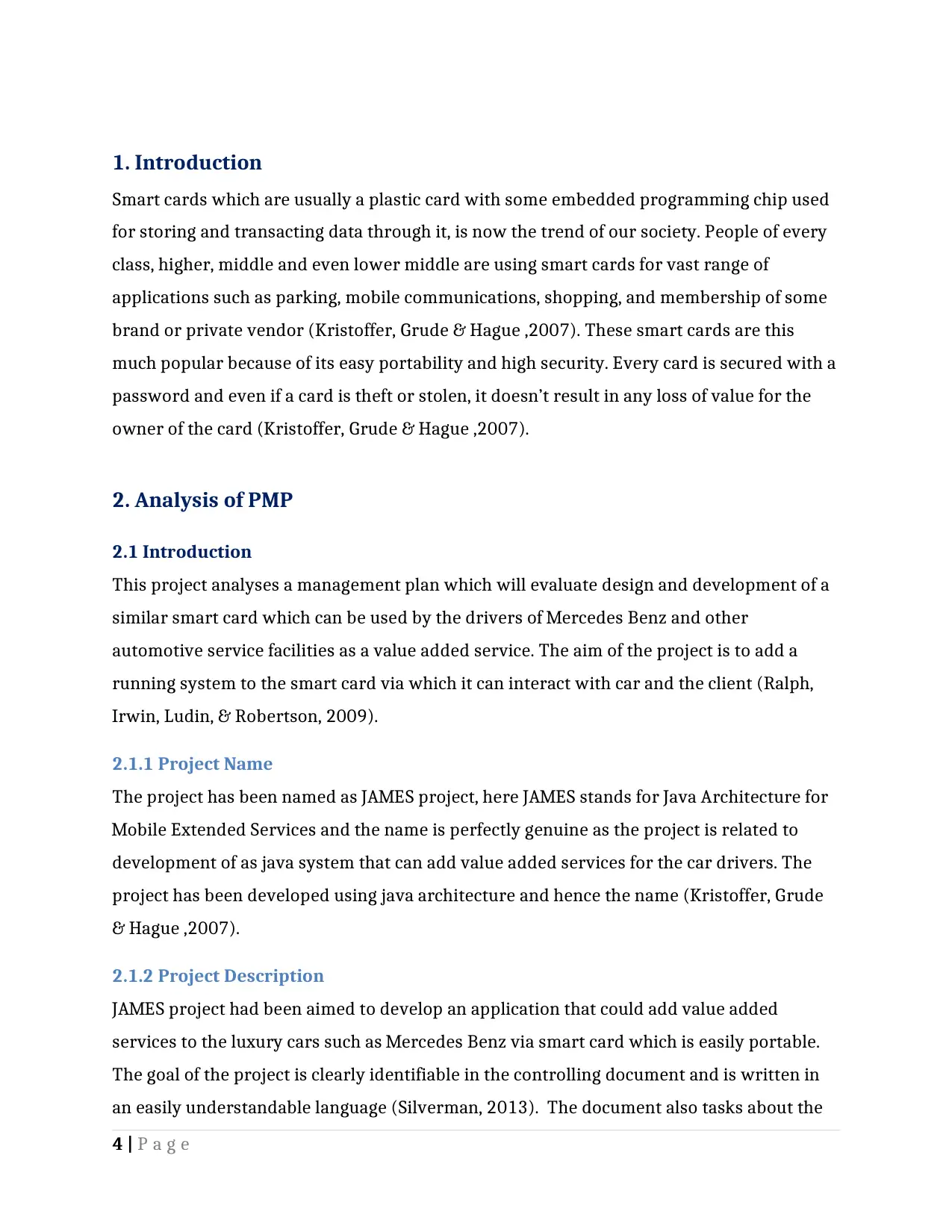
1. Introduction
Smart cards which are usually a plastic card with some embedded programming chip used
for storing and transacting data through it, is now the trend of our society. People of every
class, higher, middle and even lower middle are using smart cards for vast range of
applications such as parking, mobile communications, shopping, and membership of some
brand or private vendor (Kristoffer, Grude & Hague ,2007). These smart cards are this
much popular because of its easy portability and high security. Every card is secured with a
password and even if a card is theft or stolen, it doesn’t result in any loss of value for the
owner of the card (Kristoffer, Grude & Hague ,2007).
2. Analysis of PMP
2.1 Introduction
This project analyses a management plan which will evaluate design and development of a
similar smart card which can be used by the drivers of Mercedes Benz and other
automotive service facilities as a value added service. The aim of the project is to add a
running system to the smart card via which it can interact with car and the client (Ralph,
Irwin, Ludin, & Robertson, 2009).
2.1.1 Project Name
The project has been named as JAMES project, here JAMES stands for Java Architecture for
Mobile Extended Services and the name is perfectly genuine as the project is related to
development of as java system that can add value added services for the car drivers. The
project has been developed using java architecture and hence the name (Kristoffer, Grude
& Hague ,2007).
2.1.2 Project Description
JAMES project had been aimed to develop an application that could add value added
services to the luxury cars such as Mercedes Benz via smart card which is easily portable.
The goal of the project is clearly identifiable in the controlling document and is written in
an easily understandable language (Silverman, 2013). The document also tasks about the
4 | P a g e
Smart cards which are usually a plastic card with some embedded programming chip used
for storing and transacting data through it, is now the trend of our society. People of every
class, higher, middle and even lower middle are using smart cards for vast range of
applications such as parking, mobile communications, shopping, and membership of some
brand or private vendor (Kristoffer, Grude & Hague ,2007). These smart cards are this
much popular because of its easy portability and high security. Every card is secured with a
password and even if a card is theft or stolen, it doesn’t result in any loss of value for the
owner of the card (Kristoffer, Grude & Hague ,2007).
2. Analysis of PMP
2.1 Introduction
This project analyses a management plan which will evaluate design and development of a
similar smart card which can be used by the drivers of Mercedes Benz and other
automotive service facilities as a value added service. The aim of the project is to add a
running system to the smart card via which it can interact with car and the client (Ralph,
Irwin, Ludin, & Robertson, 2009).
2.1.1 Project Name
The project has been named as JAMES project, here JAMES stands for Java Architecture for
Mobile Extended Services and the name is perfectly genuine as the project is related to
development of as java system that can add value added services for the car drivers. The
project has been developed using java architecture and hence the name (Kristoffer, Grude
& Hague ,2007).
2.1.2 Project Description
JAMES project had been aimed to develop an application that could add value added
services to the luxury cars such as Mercedes Benz via smart card which is easily portable.
The goal of the project is clearly identifiable in the controlling document and is written in
an easily understandable language (Silverman, 2013). The document also tasks about the
4 | P a g e
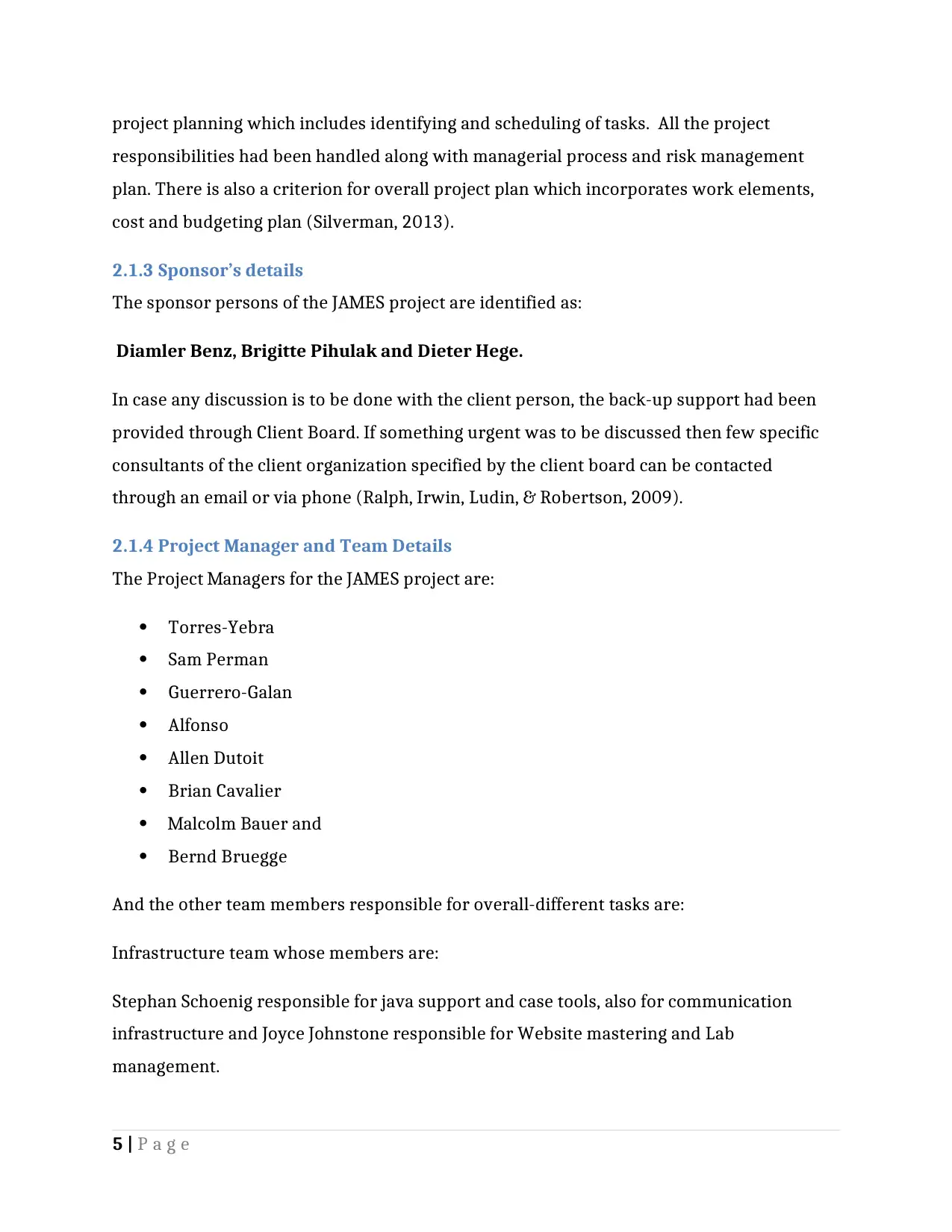
project planning which includes identifying and scheduling of tasks. All the project
responsibilities had been handled along with managerial process and risk management
plan. There is also a criterion for overall project plan which incorporates work elements,
cost and budgeting plan (Silverman, 2013).
2.1.3 Sponsor’s details
The sponsor persons of the JAMES project are identified as:
Diamler Benz, Brigitte Pihulak and Dieter Hege.
In case any discussion is to be done with the client person, the back-up support had been
provided through Client Board. If something urgent was to be discussed then few specific
consultants of the client organization specified by the client board can be contacted
through an email or via phone (Ralph, Irwin, Ludin, & Robertson, 2009).
2.1.4 Project Manager and Team Details
The Project Managers for the JAMES project are:
Torres-Yebra
Sam Perman
Guerrero-Galan
Alfonso
Allen Dutoit
Brian Cavalier
Malcolm Bauer and
Bernd Bruegge
And the other team members responsible for overall-different tasks are:
Infrastructure team whose members are:
Stephan Schoenig responsible for java support and case tools, also for communication
infrastructure and Joyce Johnstone responsible for Website mastering and Lab
management.
5 | P a g e
responsibilities had been handled along with managerial process and risk management
plan. There is also a criterion for overall project plan which incorporates work elements,
cost and budgeting plan (Silverman, 2013).
2.1.3 Sponsor’s details
The sponsor persons of the JAMES project are identified as:
Diamler Benz, Brigitte Pihulak and Dieter Hege.
In case any discussion is to be done with the client person, the back-up support had been
provided through Client Board. If something urgent was to be discussed then few specific
consultants of the client organization specified by the client board can be contacted
through an email or via phone (Ralph, Irwin, Ludin, & Robertson, 2009).
2.1.4 Project Manager and Team Details
The Project Managers for the JAMES project are:
Torres-Yebra
Sam Perman
Guerrero-Galan
Alfonso
Allen Dutoit
Brian Cavalier
Malcolm Bauer and
Bernd Bruegge
And the other team members responsible for overall-different tasks are:
Infrastructure team whose members are:
Stephan Schoenig responsible for java support and case tools, also for communication
infrastructure and Joyce Johnstone responsible for Website mastering and Lab
management.
5 | P a g e
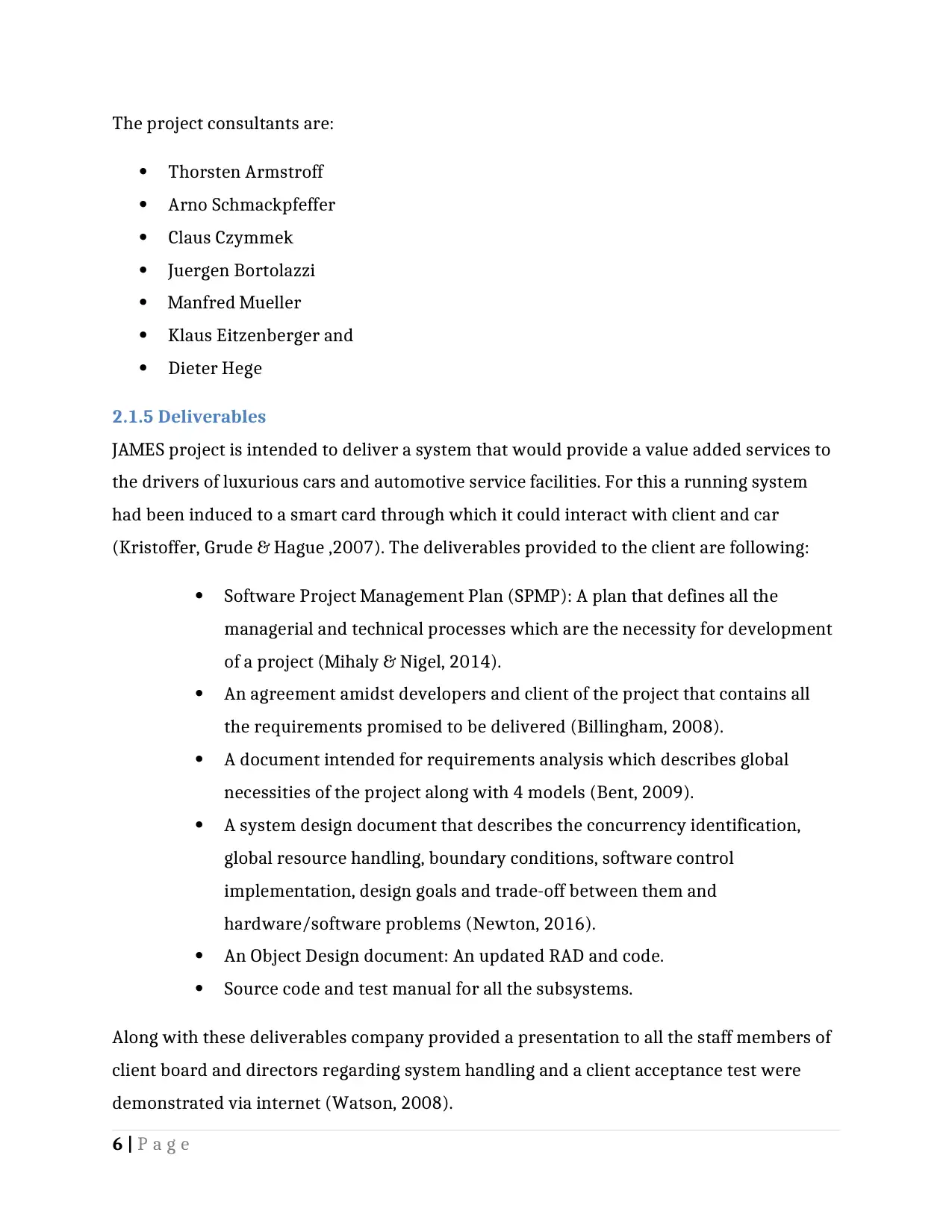
The project consultants are:
Thorsten Armstroff
Arno Schmackpfeffer
Claus Czymmek
Juergen Bortolazzi
Manfred Mueller
Klaus Eitzenberger and
Dieter Hege
2.1.5 Deliverables
JAMES project is intended to deliver a system that would provide a value added services to
the drivers of luxurious cars and automotive service facilities. For this a running system
had been induced to a smart card through which it could interact with client and car
(Kristoffer, Grude & Hague ,2007). The deliverables provided to the client are following:
Software Project Management Plan (SPMP): A plan that defines all the
managerial and technical processes which are the necessity for development
of a project (Mihaly & Nigel, 2014).
An agreement amidst developers and client of the project that contains all
the requirements promised to be delivered (Billingham, 2008).
A document intended for requirements analysis which describes global
necessities of the project along with 4 models (Bent, 2009).
A system design document that describes the concurrency identification,
global resource handling, boundary conditions, software control
implementation, design goals and trade-off between them and
hardware/software problems (Newton, 2016).
An Object Design document: An updated RAD and code.
Source code and test manual for all the subsystems.
Along with these deliverables company provided a presentation to all the staff members of
client board and directors regarding system handling and a client acceptance test were
demonstrated via internet (Watson, 2008).
6 | P a g e
Thorsten Armstroff
Arno Schmackpfeffer
Claus Czymmek
Juergen Bortolazzi
Manfred Mueller
Klaus Eitzenberger and
Dieter Hege
2.1.5 Deliverables
JAMES project is intended to deliver a system that would provide a value added services to
the drivers of luxurious cars and automotive service facilities. For this a running system
had been induced to a smart card through which it could interact with client and car
(Kristoffer, Grude & Hague ,2007). The deliverables provided to the client are following:
Software Project Management Plan (SPMP): A plan that defines all the
managerial and technical processes which are the necessity for development
of a project (Mihaly & Nigel, 2014).
An agreement amidst developers and client of the project that contains all
the requirements promised to be delivered (Billingham, 2008).
A document intended for requirements analysis which describes global
necessities of the project along with 4 models (Bent, 2009).
A system design document that describes the concurrency identification,
global resource handling, boundary conditions, software control
implementation, design goals and trade-off between them and
hardware/software problems (Newton, 2016).
An Object Design document: An updated RAD and code.
Source code and test manual for all the subsystems.
Along with these deliverables company provided a presentation to all the staff members of
client board and directors regarding system handling and a client acceptance test were
demonstrated via internet (Watson, 2008).
6 | P a g e
Paraphrase This Document
Need a fresh take? Get an instant paraphrase of this document with our AI Paraphraser
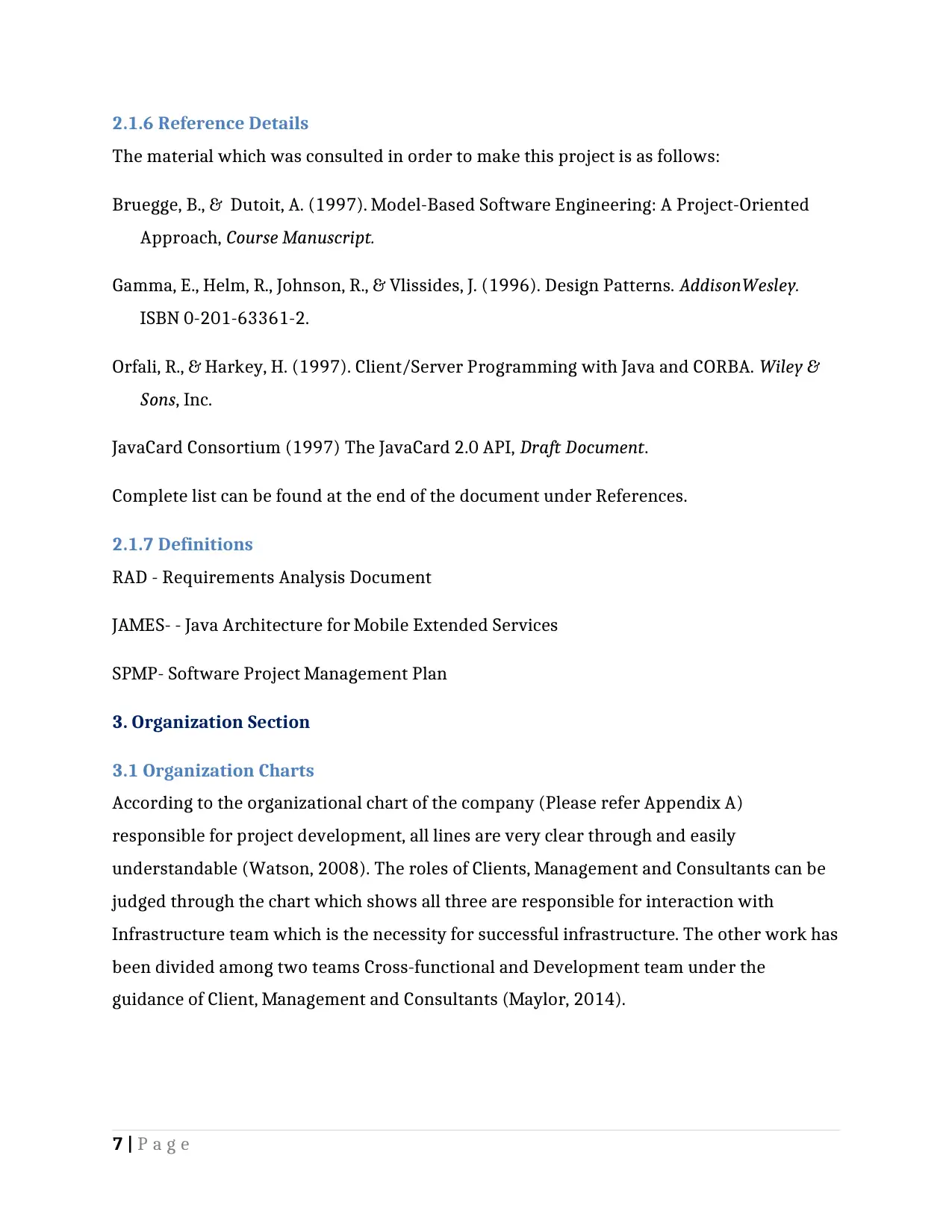
2.1.6 Reference Details
The material which was consulted in order to make this project is as follows:
Bruegge, B., & Dutoit, A. (1997). Model-Based Software Engineering: A Project-Oriented
Approach, Course Manuscript.
Gamma, E., Helm, R., Johnson, R., & Vlissides, J. (1996). Design Patterns. AddisonWesley.
ISBN 0-201-63361-2.
Orfali, R., & Harkey, H. (1997). Client/Server Programming with Java and CORBA. Wiley &
Sons, Inc.
JavaCard Consortium (1997) The JavaCard 2.0 API, Draft Document.
Complete list can be found at the end of the document under References.
2.1.7 Definitions
RAD - Requirements Analysis Document
JAMES- - Java Architecture for Mobile Extended Services
SPMP- Software Project Management Plan
3. Organization Section
3.1 Organization Charts
According to the organizational chart of the company (Please refer Appendix A)
responsible for project development, all lines are very clear through and easily
understandable (Watson, 2008). The roles of Clients, Management and Consultants can be
judged through the chart which shows all three are responsible for interaction with
Infrastructure team which is the necessity for successful infrastructure. The other work has
been divided among two teams Cross-functional and Development team under the
guidance of Client, Management and Consultants (Maylor, 2014).
7 | P a g e
The material which was consulted in order to make this project is as follows:
Bruegge, B., & Dutoit, A. (1997). Model-Based Software Engineering: A Project-Oriented
Approach, Course Manuscript.
Gamma, E., Helm, R., Johnson, R., & Vlissides, J. (1996). Design Patterns. AddisonWesley.
ISBN 0-201-63361-2.
Orfali, R., & Harkey, H. (1997). Client/Server Programming with Java and CORBA. Wiley &
Sons, Inc.
JavaCard Consortium (1997) The JavaCard 2.0 API, Draft Document.
Complete list can be found at the end of the document under References.
2.1.7 Definitions
RAD - Requirements Analysis Document
JAMES- - Java Architecture for Mobile Extended Services
SPMP- Software Project Management Plan
3. Organization Section
3.1 Organization Charts
According to the organizational chart of the company (Please refer Appendix A)
responsible for project development, all lines are very clear through and easily
understandable (Watson, 2008). The roles of Clients, Management and Consultants can be
judged through the chart which shows all three are responsible for interaction with
Infrastructure team which is the necessity for successful infrastructure. The other work has
been divided among two teams Cross-functional and Development team under the
guidance of Client, Management and Consultants (Maylor, 2014).
7 | P a g e
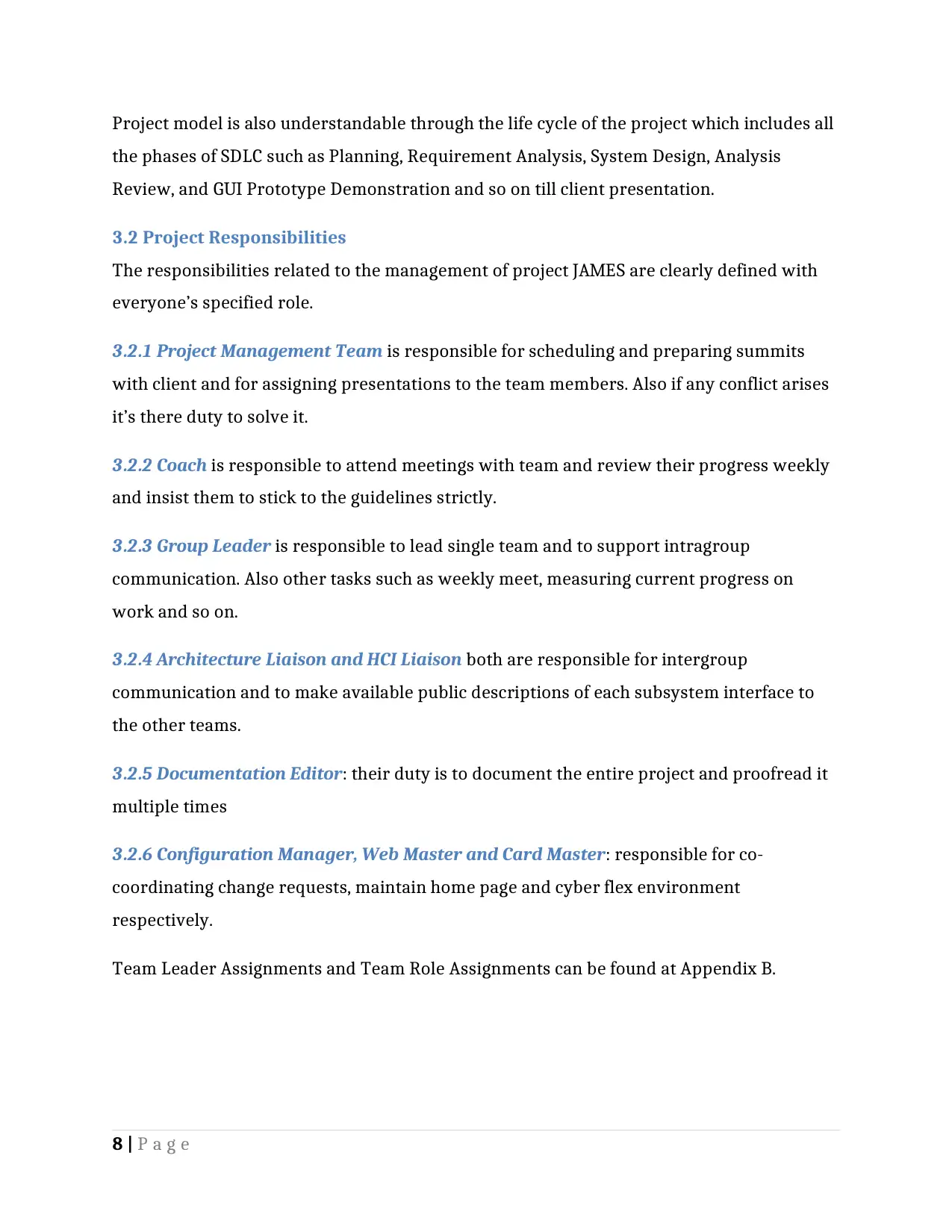
Project model is also understandable through the life cycle of the project which includes all
the phases of SDLC such as Planning, Requirement Analysis, System Design, Analysis
Review, and GUI Prototype Demonstration and so on till client presentation.
3.2 Project Responsibilities
The responsibilities related to the management of project JAMES are clearly defined with
everyone’s specified role.
3.2.1 Project Management Team is responsible for scheduling and preparing summits
with client and for assigning presentations to the team members. Also if any conflict arises
it’s there duty to solve it.
3.2.2 Coach is responsible to attend meetings with team and review their progress weekly
and insist them to stick to the guidelines strictly.
3.2.3 Group Leader is responsible to lead single team and to support intragroup
communication. Also other tasks such as weekly meet, measuring current progress on
work and so on.
3.2.4 Architecture Liaison and HCI Liaison both are responsible for intergroup
communication and to make available public descriptions of each subsystem interface to
the other teams.
3.2.5 Documentation Editor: their duty is to document the entire project and proofread it
multiple times
3.2.6 Configuration Manager, Web Master and Card Master: responsible for co-
coordinating change requests, maintain home page and cyber flex environment
respectively.
Team Leader Assignments and Team Role Assignments can be found at Appendix B.
8 | P a g e
the phases of SDLC such as Planning, Requirement Analysis, System Design, Analysis
Review, and GUI Prototype Demonstration and so on till client presentation.
3.2 Project Responsibilities
The responsibilities related to the management of project JAMES are clearly defined with
everyone’s specified role.
3.2.1 Project Management Team is responsible for scheduling and preparing summits
with client and for assigning presentations to the team members. Also if any conflict arises
it’s there duty to solve it.
3.2.2 Coach is responsible to attend meetings with team and review their progress weekly
and insist them to stick to the guidelines strictly.
3.2.3 Group Leader is responsible to lead single team and to support intragroup
communication. Also other tasks such as weekly meet, measuring current progress on
work and so on.
3.2.4 Architecture Liaison and HCI Liaison both are responsible for intergroup
communication and to make available public descriptions of each subsystem interface to
the other teams.
3.2.5 Documentation Editor: their duty is to document the entire project and proofread it
multiple times
3.2.6 Configuration Manager, Web Master and Card Master: responsible for co-
coordinating change requests, maintain home page and cyber flex environment
respectively.
Team Leader Assignments and Team Role Assignments can be found at Appendix B.
8 | P a g e
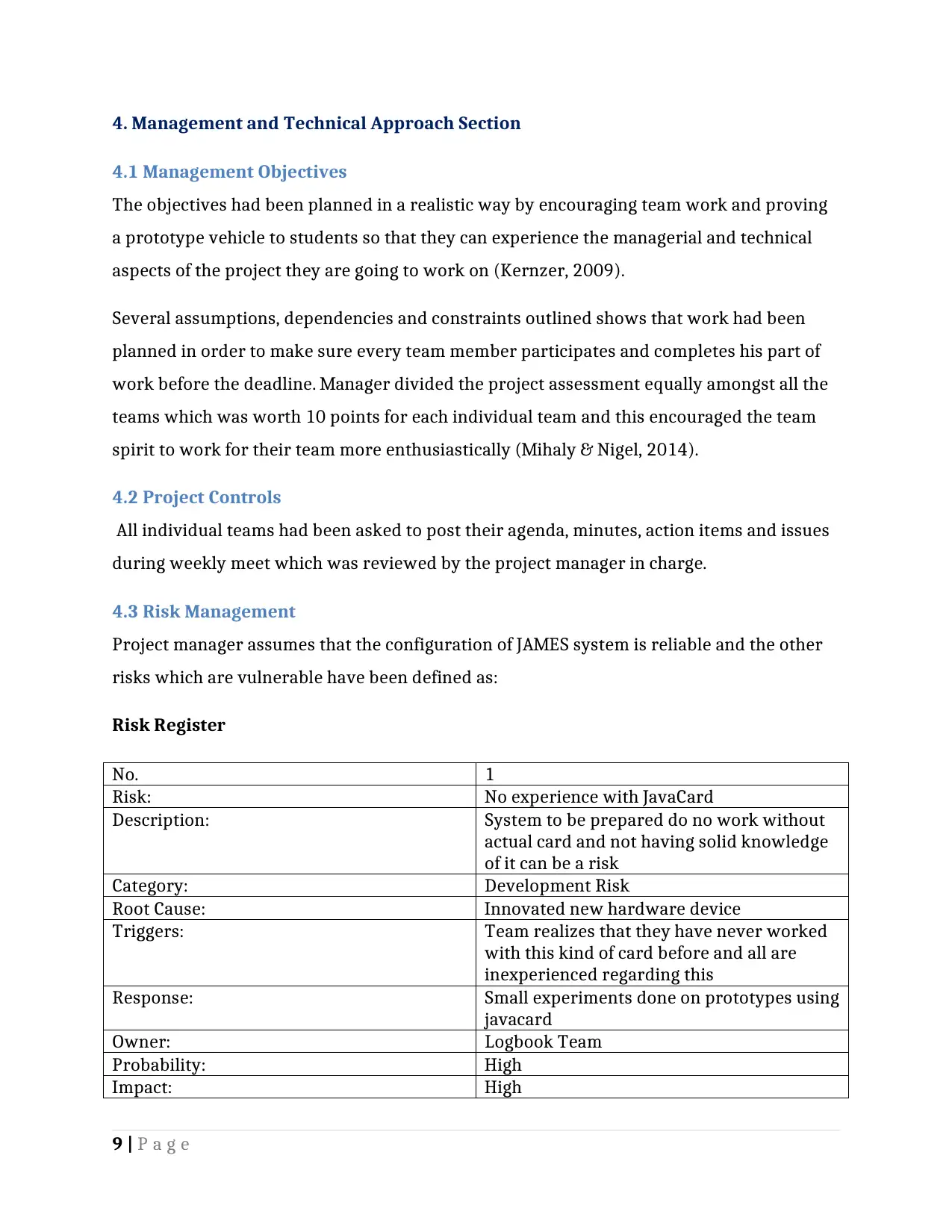
4. Management and Technical Approach Section
4.1 Management Objectives
The objectives had been planned in a realistic way by encouraging team work and proving
a prototype vehicle to students so that they can experience the managerial and technical
aspects of the project they are going to work on (Kernzer, 2009).
Several assumptions, dependencies and constraints outlined shows that work had been
planned in order to make sure every team member participates and completes his part of
work before the deadline. Manager divided the project assessment equally amongst all the
teams which was worth 10 points for each individual team and this encouraged the team
spirit to work for their team more enthusiastically (Mihaly & Nigel, 2014).
4.2 Project Controls
All individual teams had been asked to post their agenda, minutes, action items and issues
during weekly meet which was reviewed by the project manager in charge.
4.3 Risk Management
Project manager assumes that the configuration of JAMES system is reliable and the other
risks which are vulnerable have been defined as:
Risk Register
No. 1
Risk: No experience with JavaCard
Description: System to be prepared do no work without
actual card and not having solid knowledge
of it can be a risk
Category: Development Risk
Root Cause: Innovated new hardware device
Triggers: Team realizes that they have never worked
with this kind of card before and all are
inexperienced regarding this
Response: Small experiments done on prototypes using
javacard
Owner: Logbook Team
Probability: High
Impact: High
9 | P a g e
4.1 Management Objectives
The objectives had been planned in a realistic way by encouraging team work and proving
a prototype vehicle to students so that they can experience the managerial and technical
aspects of the project they are going to work on (Kernzer, 2009).
Several assumptions, dependencies and constraints outlined shows that work had been
planned in order to make sure every team member participates and completes his part of
work before the deadline. Manager divided the project assessment equally amongst all the
teams which was worth 10 points for each individual team and this encouraged the team
spirit to work for their team more enthusiastically (Mihaly & Nigel, 2014).
4.2 Project Controls
All individual teams had been asked to post their agenda, minutes, action items and issues
during weekly meet which was reviewed by the project manager in charge.
4.3 Risk Management
Project manager assumes that the configuration of JAMES system is reliable and the other
risks which are vulnerable have been defined as:
Risk Register
No. 1
Risk: No experience with JavaCard
Description: System to be prepared do no work without
actual card and not having solid knowledge
of it can be a risk
Category: Development Risk
Root Cause: Innovated new hardware device
Triggers: Team realizes that they have never worked
with this kind of card before and all are
inexperienced regarding this
Response: Small experiments done on prototypes using
javacard
Owner: Logbook Team
Probability: High
Impact: High
9 | P a g e
Secure Best Marks with AI Grader
Need help grading? Try our AI Grader for instant feedback on your assignments.

No. 2
Risk: Limitation of data due to car interface
Description: Depending upon the car model collection of
data may be limited which may not allow
creation of a tax deductible form
Category: Financial risk
Root Cause: Car model
Triggers: While experimenting on prototypes of car
problem triggered
Response: A partial form must be created
Owner: Logbook Team
Probability: Low
Impact: High
No. 3
Risk: Missed Important feature
Description: A part of the project which was responsible
for an important function has been left from
being created
Category: Implementation risk
Root Cause: Over-enthusiasm and resource constraints
Triggers: Prototype not working as it should be
Response: Prototype of the omitted feature created and
reviewed by client liaison
Owner: Maintenance Team
Probability: low
Impact: medium
10 | P a g e
Risk: Limitation of data due to car interface
Description: Depending upon the car model collection of
data may be limited which may not allow
creation of a tax deductible form
Category: Financial risk
Root Cause: Car model
Triggers: While experimenting on prototypes of car
problem triggered
Response: A partial form must be created
Owner: Logbook Team
Probability: Low
Impact: High
No. 3
Risk: Missed Important feature
Description: A part of the project which was responsible
for an important function has been left from
being created
Category: Implementation risk
Root Cause: Over-enthusiasm and resource constraints
Triggers: Prototype not working as it should be
Response: Prototype of the omitted feature created and
reviewed by client liaison
Owner: Maintenance Team
Probability: low
Impact: medium
10 | P a g e
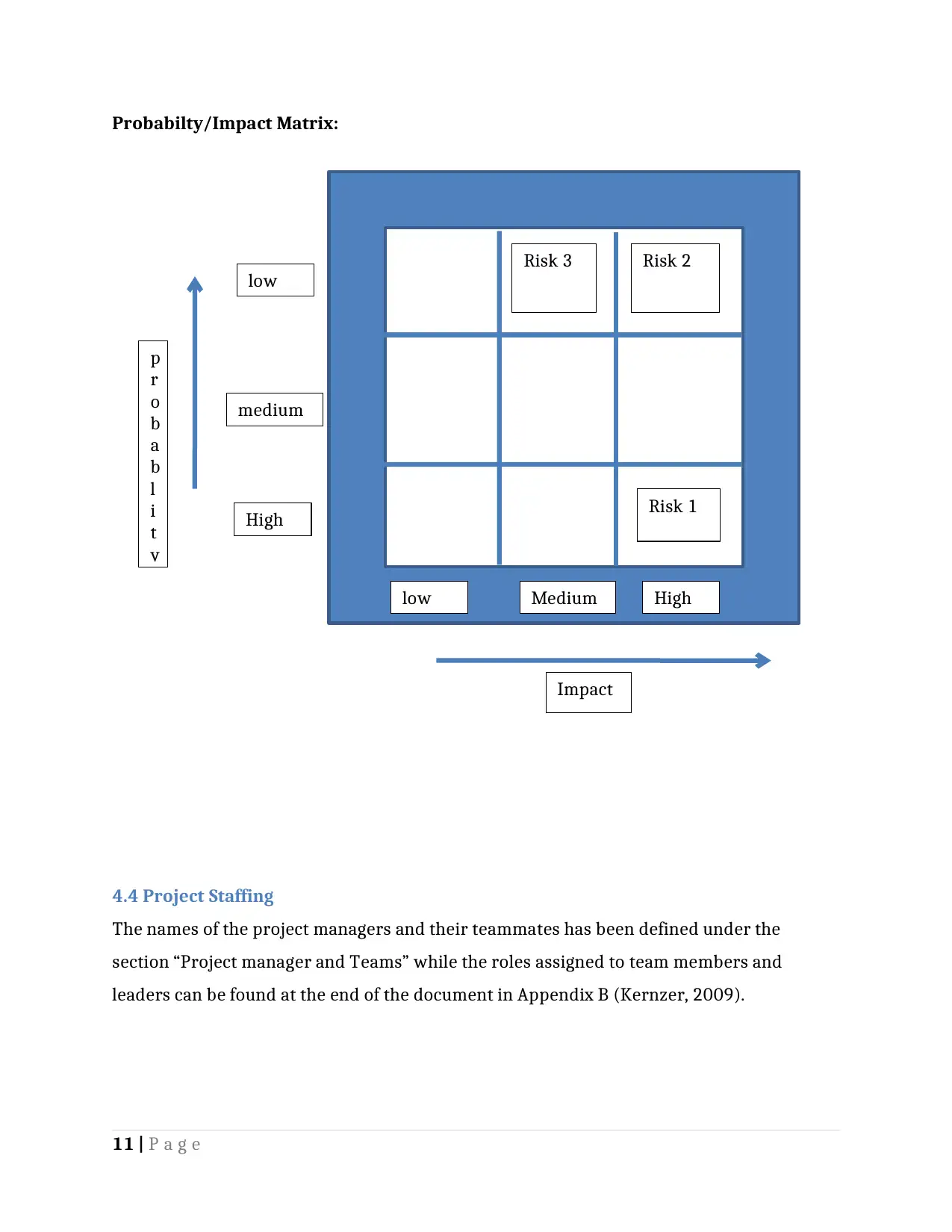
Probabilty/Impact Matrix:
4.4 Project Staffing
The names of the project managers and their teammates has been defined under the
section “Project manager and Teams” while the roles assigned to team members and
leaders can be found at the end of the document in Appendix B (Kernzer, 2009).
11 | P a g e
Risk 3 Risk 2
Risk 1
Impact
p
r
o
b
a
b
l
i
t
y
low Medium High
High
medium
low
4.4 Project Staffing
The names of the project managers and their teammates has been defined under the
section “Project manager and Teams” while the roles assigned to team members and
leaders can be found at the end of the document in Appendix B (Kernzer, 2009).
11 | P a g e
Risk 3 Risk 2
Risk 1
Impact
p
r
o
b
a
b
l
i
t
y
low Medium High
High
medium
low
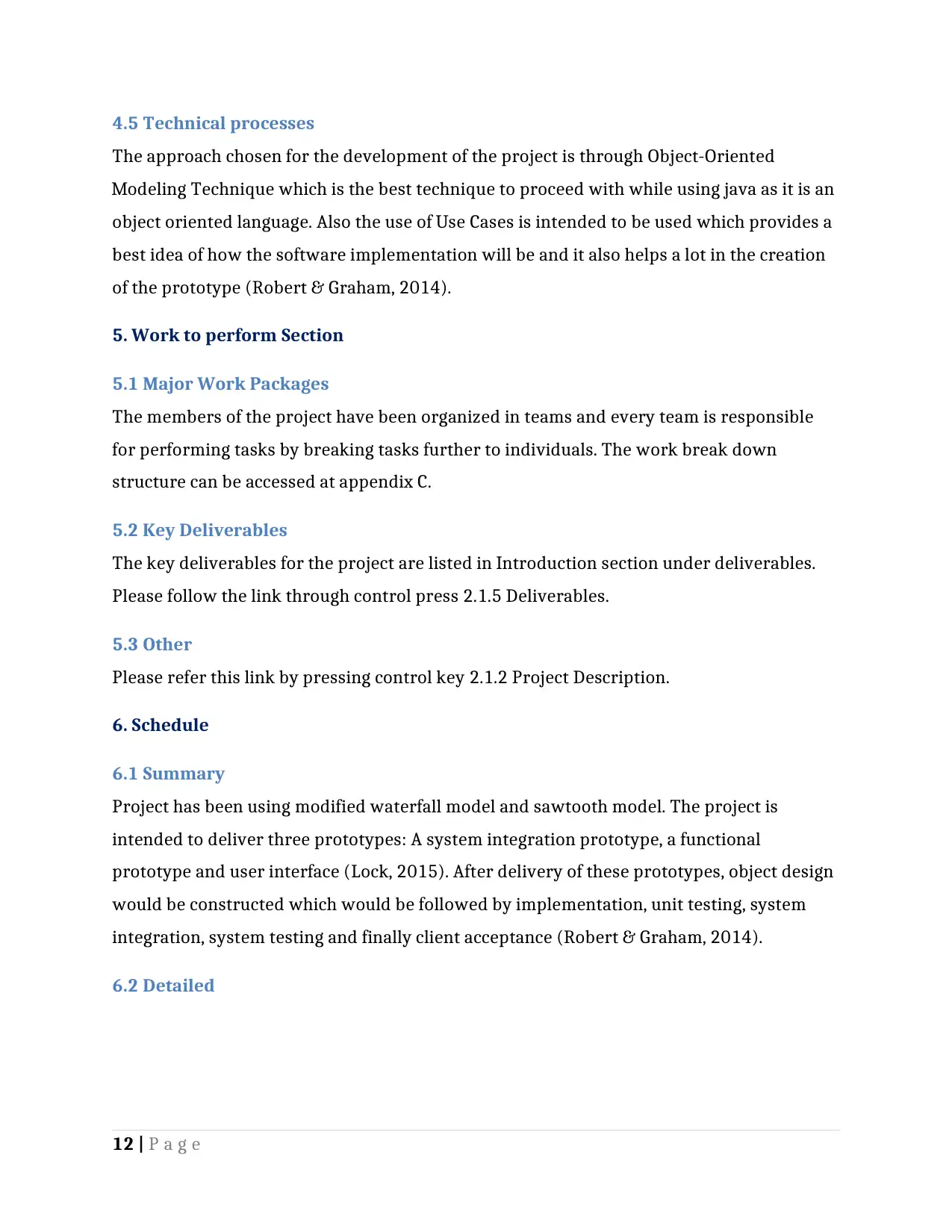
4.5 Technical processes
The approach chosen for the development of the project is through Object-Oriented
Modeling Technique which is the best technique to proceed with while using java as it is an
object oriented language. Also the use of Use Cases is intended to be used which provides a
best idea of how the software implementation will be and it also helps a lot in the creation
of the prototype (Robert & Graham, 2014).
5. Work to perform Section
5.1 Major Work Packages
The members of the project have been organized in teams and every team is responsible
for performing tasks by breaking tasks further to individuals. The work break down
structure can be accessed at appendix C.
5.2 Key Deliverables
The key deliverables for the project are listed in Introduction section under deliverables.
Please follow the link through control press 2.1.5 Deliverables.
5.3 Other
Please refer this link by pressing control key 2.1.2 Project Description.
6. Schedule
6.1 Summary
Project has been using modified waterfall model and sawtooth model. The project is
intended to deliver three prototypes: A system integration prototype, a functional
prototype and user interface (Lock, 2015). After delivery of these prototypes, object design
would be constructed which would be followed by implementation, unit testing, system
integration, system testing and finally client acceptance (Robert & Graham, 2014).
6.2 Detailed
12 | P a g e
The approach chosen for the development of the project is through Object-Oriented
Modeling Technique which is the best technique to proceed with while using java as it is an
object oriented language. Also the use of Use Cases is intended to be used which provides a
best idea of how the software implementation will be and it also helps a lot in the creation
of the prototype (Robert & Graham, 2014).
5. Work to perform Section
5.1 Major Work Packages
The members of the project have been organized in teams and every team is responsible
for performing tasks by breaking tasks further to individuals. The work break down
structure can be accessed at appendix C.
5.2 Key Deliverables
The key deliverables for the project are listed in Introduction section under deliverables.
Please follow the link through control press 2.1.5 Deliverables.
5.3 Other
Please refer this link by pressing control key 2.1.2 Project Description.
6. Schedule
6.1 Summary
Project has been using modified waterfall model and sawtooth model. The project is
intended to deliver three prototypes: A system integration prototype, a functional
prototype and user interface (Lock, 2015). After delivery of these prototypes, object design
would be constructed which would be followed by implementation, unit testing, system
integration, system testing and finally client acceptance (Robert & Graham, 2014).
6.2 Detailed
12 | P a g e
Paraphrase This Document
Need a fresh take? Get an instant paraphrase of this document with our AI Paraphraser
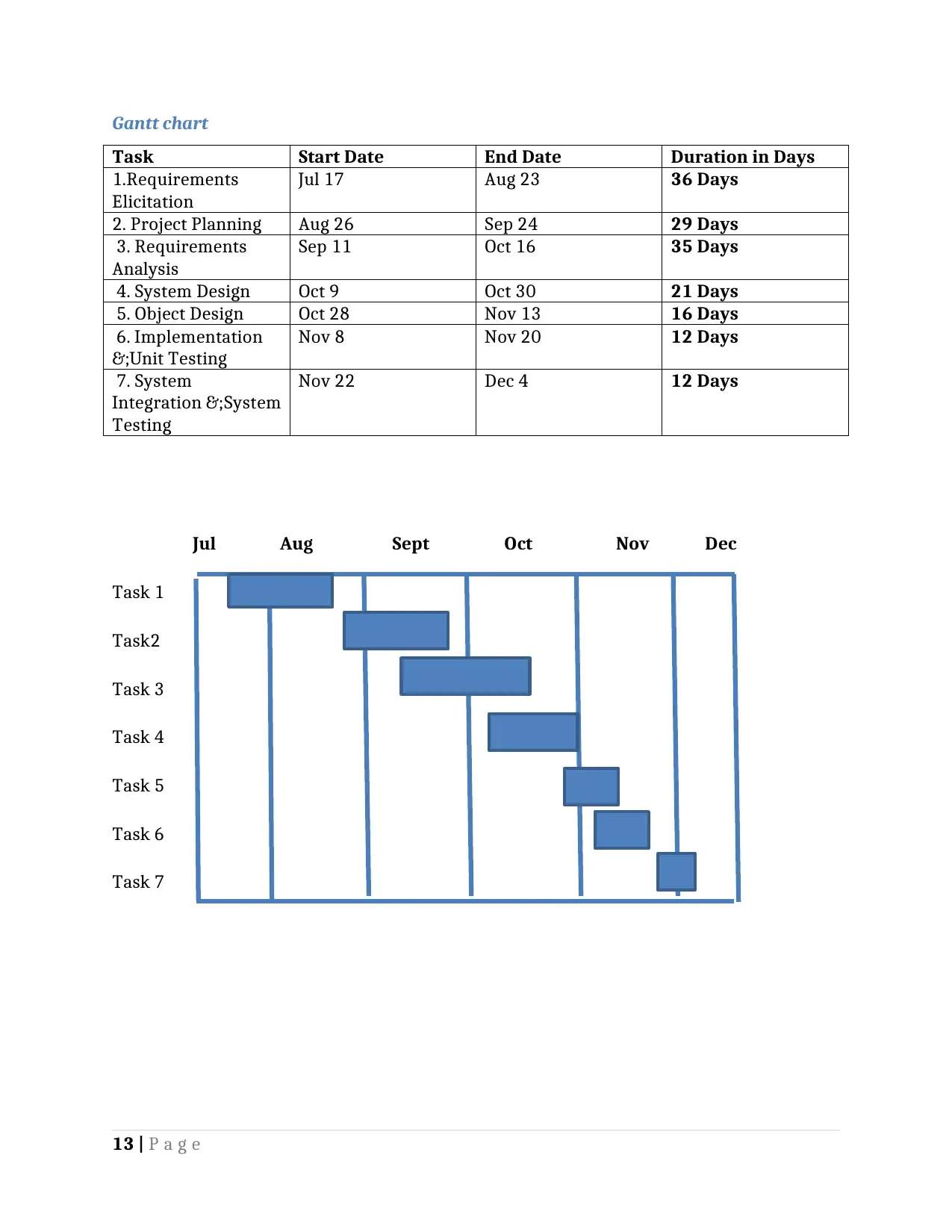
Gantt chart
Task Start Date End Date Duration in Days
1.Requirements
Elicitation
Jul 17 Aug 23 36 Days
2. Project Planning Aug 26 Sep 24 29 Days
3. Requirements
Analysis
Sep 11 Oct 16 35 Days
4. System Design Oct 9 Oct 30 21 Days
5. Object Design Oct 28 Nov 13 16 Days
6. Implementation
&;Unit Testing
Nov 8 Nov 20 12 Days
7. System
Integration &;System
Testing
Nov 22 Dec 4 12 Days
Jul Aug Sept Oct Nov Dec
Task 1
Task2
Task 3
Task 4
Task 5
Task 6
Task 7
13 | P a g e
Task Start Date End Date Duration in Days
1.Requirements
Elicitation
Jul 17 Aug 23 36 Days
2. Project Planning Aug 26 Sep 24 29 Days
3. Requirements
Analysis
Sep 11 Oct 16 35 Days
4. System Design Oct 9 Oct 30 21 Days
5. Object Design Oct 28 Nov 13 16 Days
6. Implementation
&;Unit Testing
Nov 8 Nov 20 12 Days
7. System
Integration &;System
Testing
Nov 22 Dec 4 12 Days
Jul Aug Sept Oct Nov Dec
Task 1
Task2
Task 3
Task 4
Task 5
Task 6
Task 7
13 | P a g e
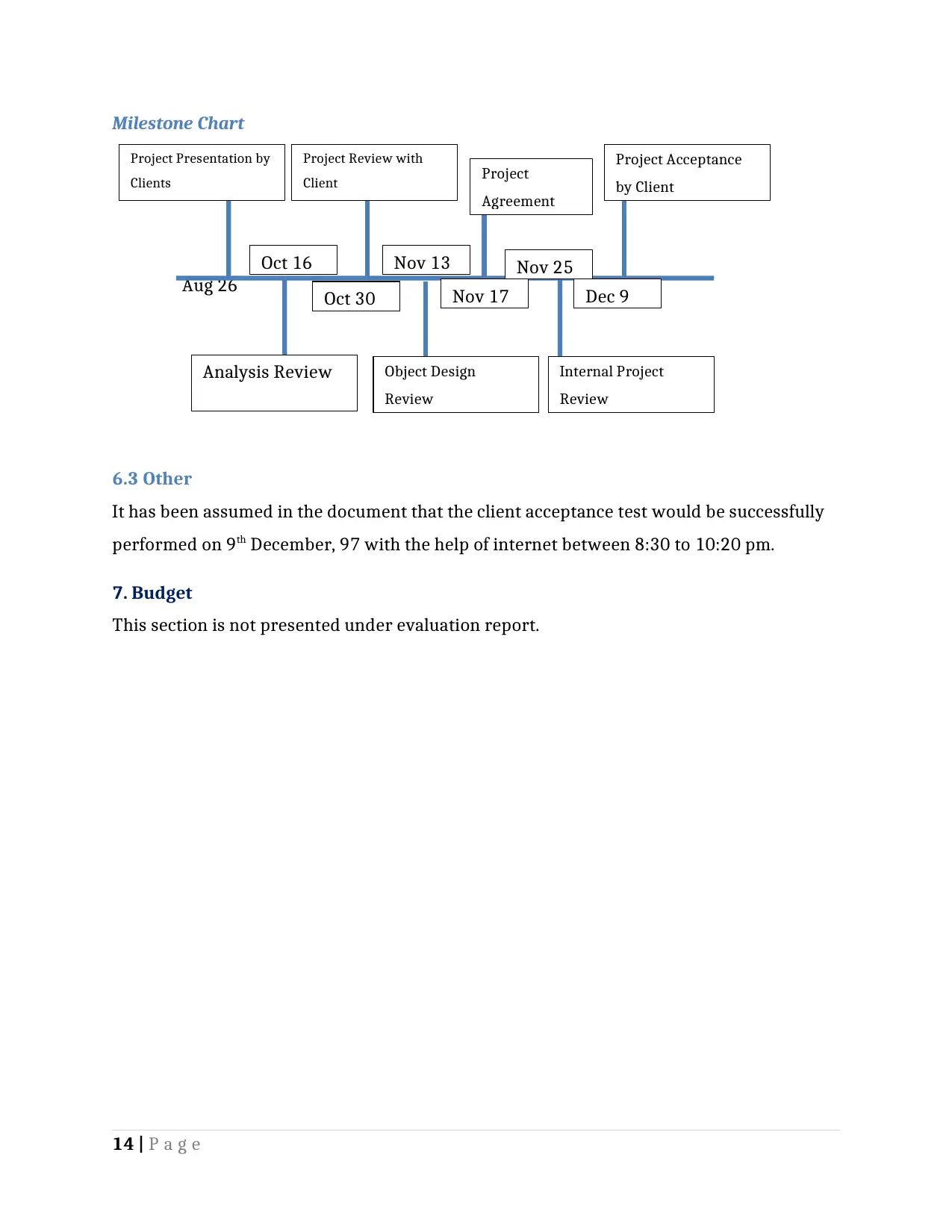
Milestone Chart
Aug 26
6.3 Other
It has been assumed in the document that the client acceptance test would be successfully
performed on 9th December, 97 with the help of internet between 8:30 to 10:20 pm.
7. Budget
This section is not presented under evaluation report.
14 | P a g e
Oct 16
Oct 30
Nov 13
Nov 17
Nov 25
Dec 9
Project Presentation by
Clients
Project Review with
Client Project
Agreement
Project Acceptance
by Client
Analysis Review Object Design
Review
Internal Project
Review
Aug 26
6.3 Other
It has been assumed in the document that the client acceptance test would be successfully
performed on 9th December, 97 with the help of internet between 8:30 to 10:20 pm.
7. Budget
This section is not presented under evaluation report.
14 | P a g e
Oct 16
Oct 30
Nov 13
Nov 17
Nov 25
Dec 9
Project Presentation by
Clients
Project Review with
Client Project
Agreement
Project Acceptance
by Client
Analysis Review Object Design
Review
Internal Project
Review
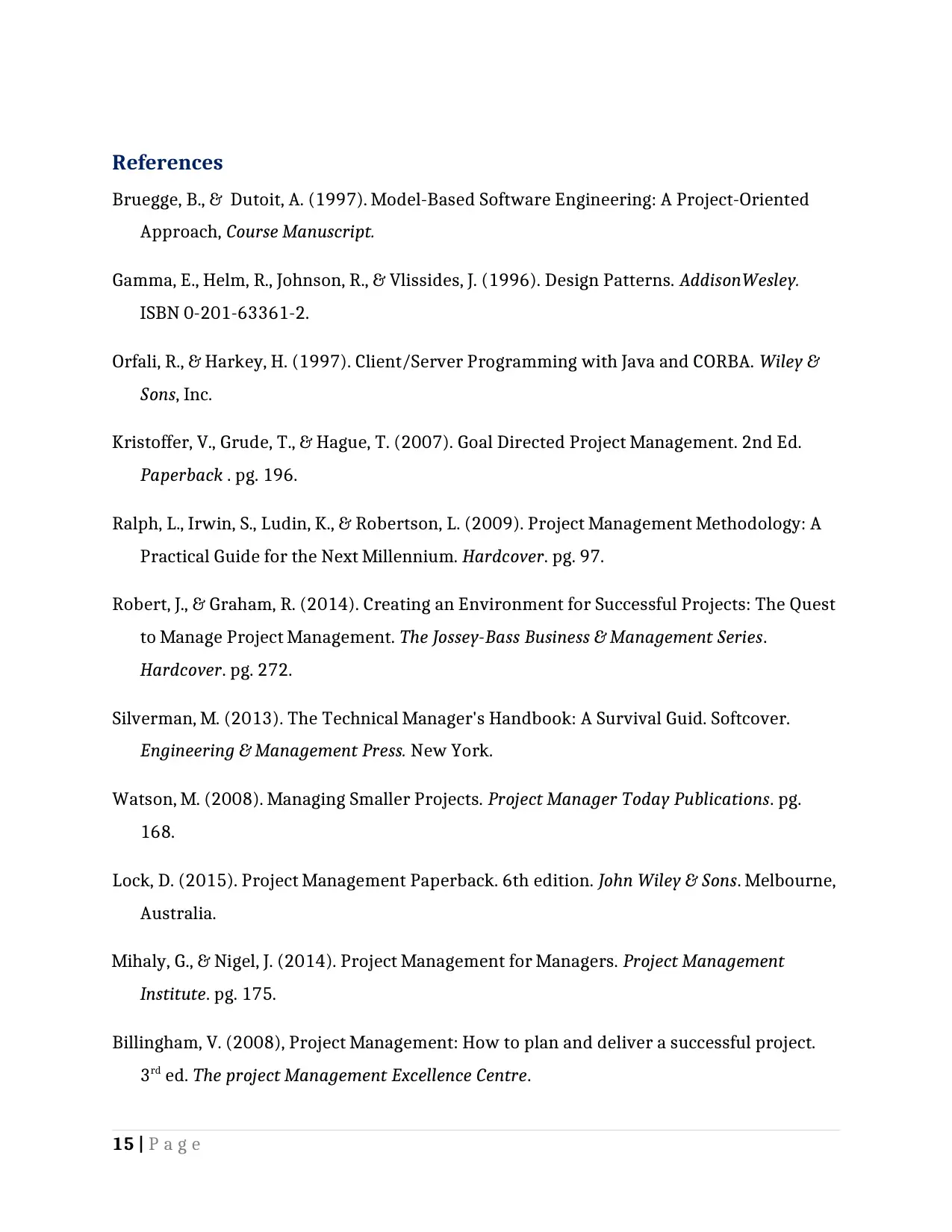
References
Bruegge, B., & Dutoit, A. (1997). Model-Based Software Engineering: A Project-Oriented
Approach, Course Manuscript.
Gamma, E., Helm, R., Johnson, R., & Vlissides, J. (1996). Design Patterns. AddisonWesley.
ISBN 0-201-63361-2.
Orfali, R., & Harkey, H. (1997). Client/Server Programming with Java and CORBA. Wiley &
Sons, Inc.
Kristoffer, V., Grude, T., & Hague, T. (2007). Goal Directed Project Management. 2nd Ed.
Paperback . pg. 196.
Ralph, L., Irwin, S., Ludin, K., & Robertson, L. (2009). Project Management Methodology: A
Practical Guide for the Next Millennium. Hardcover. pg. 97.
Robert, J., & Graham, R. (2014). Creating an Environment for Successful Projects: The Quest
to Manage Project Management. The Jossey-Bass Business & Management Series.
Hardcover. pg. 272.
Silverman, M. (2013). The Technical Manager's Handbook: A Survival Guid. Softcover.
Engineering & Management Press. New York.
Watson, M. (2008). Managing Smaller Projects. Project Manager Today Publications. pg.
168.
Lock, D. (2015). Project Management Paperback. 6th edition. John Wiley & Sons. Melbourne,
Australia.
Mihaly, G., & Nigel, J. (2014). Project Management for Managers. Project Management
Institute. pg. 175.
Billingham, V. (2008), Project Management: How to plan and deliver a successful project.
3rd ed. The project Management Excellence Centre.
15 | P a g e
Bruegge, B., & Dutoit, A. (1997). Model-Based Software Engineering: A Project-Oriented
Approach, Course Manuscript.
Gamma, E., Helm, R., Johnson, R., & Vlissides, J. (1996). Design Patterns. AddisonWesley.
ISBN 0-201-63361-2.
Orfali, R., & Harkey, H. (1997). Client/Server Programming with Java and CORBA. Wiley &
Sons, Inc.
Kristoffer, V., Grude, T., & Hague, T. (2007). Goal Directed Project Management. 2nd Ed.
Paperback . pg. 196.
Ralph, L., Irwin, S., Ludin, K., & Robertson, L. (2009). Project Management Methodology: A
Practical Guide for the Next Millennium. Hardcover. pg. 97.
Robert, J., & Graham, R. (2014). Creating an Environment for Successful Projects: The Quest
to Manage Project Management. The Jossey-Bass Business & Management Series.
Hardcover. pg. 272.
Silverman, M. (2013). The Technical Manager's Handbook: A Survival Guid. Softcover.
Engineering & Management Press. New York.
Watson, M. (2008). Managing Smaller Projects. Project Manager Today Publications. pg.
168.
Lock, D. (2015). Project Management Paperback. 6th edition. John Wiley & Sons. Melbourne,
Australia.
Mihaly, G., & Nigel, J. (2014). Project Management for Managers. Project Management
Institute. pg. 175.
Billingham, V. (2008), Project Management: How to plan and deliver a successful project.
3rd ed. The project Management Excellence Centre.
15 | P a g e
Secure Best Marks with AI Grader
Need help grading? Try our AI Grader for instant feedback on your assignments.
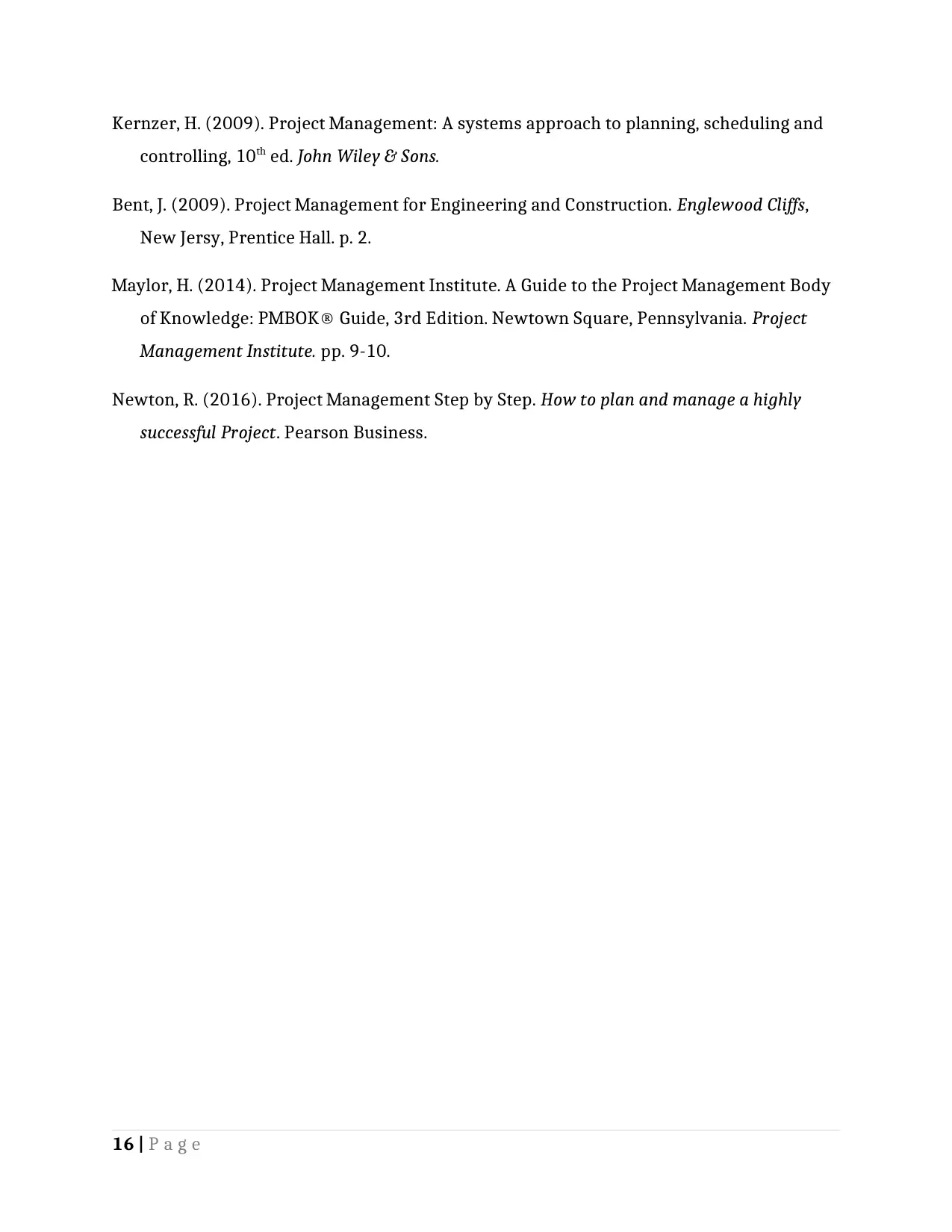
Kernzer, H. (2009). Project Management: A systems approach to planning, scheduling and
controlling, 10th ed. John Wiley & Sons.
Bent, J. (2009). Project Management for Engineering and Construction. Englewood Cliffs,
New Jersy, Prentice Hall. p. 2.
Maylor, H. (2014). Project Management Institute. A Guide to the Project Management Body
of Knowledge: PMBOK® Guide, 3rd Edition. Newtown Square, Pennsylvania. Project
Management Institute. pp. 9-10.
Newton, R. (2016). Project Management Step by Step. How to plan and manage a highly
successful Project. Pearson Business.
16 | P a g e
controlling, 10th ed. John Wiley & Sons.
Bent, J. (2009). Project Management for Engineering and Construction. Englewood Cliffs,
New Jersy, Prentice Hall. p. 2.
Maylor, H. (2014). Project Management Institute. A Guide to the Project Management Body
of Knowledge: PMBOK® Guide, 3rd Edition. Newtown Square, Pennsylvania. Project
Management Institute. pp. 9-10.
Newton, R. (2016). Project Management Step by Step. How to plan and manage a highly
successful Project. Pearson Business.
16 | P a g e
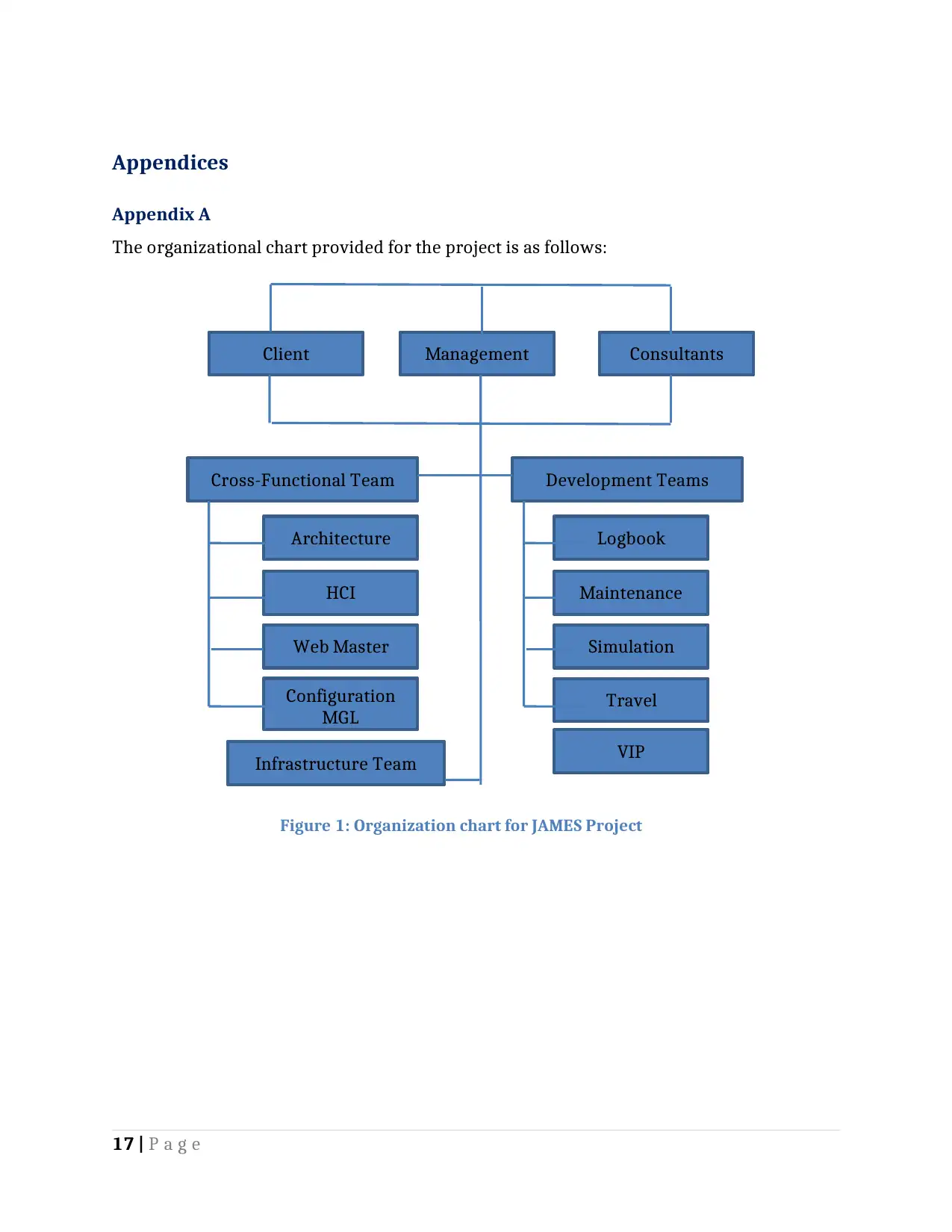
Appendices
Appendix A
The organizational chart provided for the project is as follows:
Figure 1: Organization chart for JAMES Project
17 | P a g e
VIP
Travel
Simulation
Development Teams
Configuration
MGL
Web Master
HCI
Architecture
Cross-Functional Team
Infrastructure Team
Management ConsultantsClient
Maintenance
Logbook
Appendix A
The organizational chart provided for the project is as follows:
Figure 1: Organization chart for JAMES Project
17 | P a g e
VIP
Travel
Simulation
Development Teams
Configuration
MGL
Web Master
HCI
Architecture
Cross-Functional Team
Infrastructure Team
Management ConsultantsClient
Maintenance
Logbook
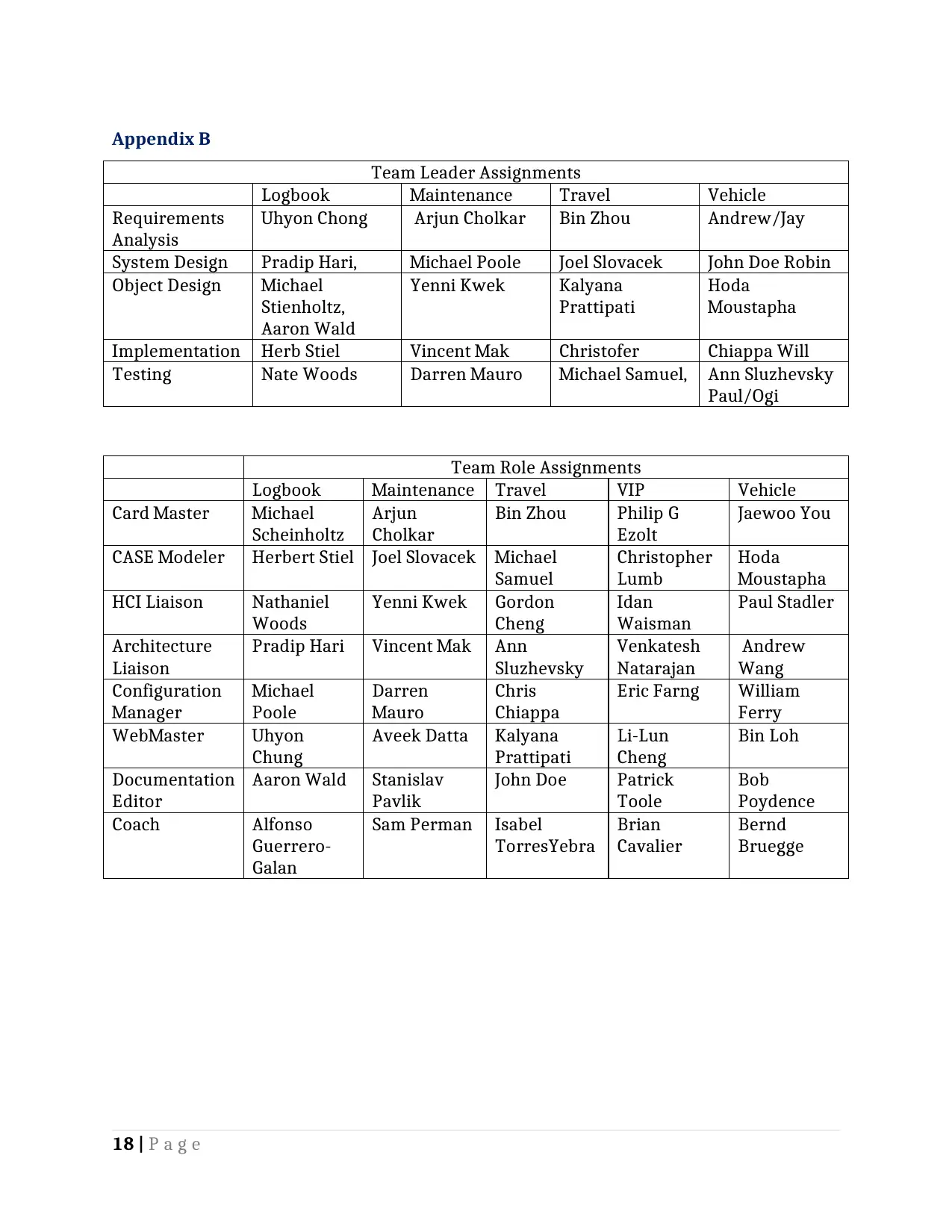
Appendix B
Team Leader Assignments
Logbook Maintenance Travel Vehicle
Requirements
Analysis
Uhyon Chong Arjun Cholkar Bin Zhou Andrew/Jay
System Design Pradip Hari, Michael Poole Joel Slovacek John Doe Robin
Object Design Michael
Stienholtz,
Aaron Wald
Yenni Kwek Kalyana
Prattipati
Hoda
Moustapha
Implementation Herb Stiel Vincent Mak Christofer Chiappa Will
Testing Nate Woods Darren Mauro Michael Samuel, Ann Sluzhevsky
Paul/Ogi
Team Role Assignments
Logbook Maintenance Travel VIP Vehicle
Card Master Michael
Scheinholtz
Arjun
Cholkar
Bin Zhou Philip G
Ezolt
Jaewoo You
CASE Modeler Herbert Stiel Joel Slovacek Michael
Samuel
Christopher
Lumb
Hoda
Moustapha
HCI Liaison Nathaniel
Woods
Yenni Kwek Gordon
Cheng
Idan
Waisman
Paul Stadler
Architecture
Liaison
Pradip Hari Vincent Mak Ann
Sluzhevsky
Venkatesh
Natarajan
Andrew
Wang
Configuration
Manager
Michael
Poole
Darren
Mauro
Chris
Chiappa
Eric Farng William
Ferry
WebMaster Uhyon
Chung
Aveek Datta Kalyana
Prattipati
Li-Lun
Cheng
Bin Loh
Documentation
Editor
Aaron Wald Stanislav
Pavlik
John Doe Patrick
Toole
Bob
Poydence
Coach Alfonso
Guerrero-
Galan
Sam Perman Isabel
TorresYebra
Brian
Cavalier
Bernd
Bruegge
18 | P a g e
Team Leader Assignments
Logbook Maintenance Travel Vehicle
Requirements
Analysis
Uhyon Chong Arjun Cholkar Bin Zhou Andrew/Jay
System Design Pradip Hari, Michael Poole Joel Slovacek John Doe Robin
Object Design Michael
Stienholtz,
Aaron Wald
Yenni Kwek Kalyana
Prattipati
Hoda
Moustapha
Implementation Herb Stiel Vincent Mak Christofer Chiappa Will
Testing Nate Woods Darren Mauro Michael Samuel, Ann Sluzhevsky
Paul/Ogi
Team Role Assignments
Logbook Maintenance Travel VIP Vehicle
Card Master Michael
Scheinholtz
Arjun
Cholkar
Bin Zhou Philip G
Ezolt
Jaewoo You
CASE Modeler Herbert Stiel Joel Slovacek Michael
Samuel
Christopher
Lumb
Hoda
Moustapha
HCI Liaison Nathaniel
Woods
Yenni Kwek Gordon
Cheng
Idan
Waisman
Paul Stadler
Architecture
Liaison
Pradip Hari Vincent Mak Ann
Sluzhevsky
Venkatesh
Natarajan
Andrew
Wang
Configuration
Manager
Michael
Poole
Darren
Mauro
Chris
Chiappa
Eric Farng William
Ferry
WebMaster Uhyon
Chung
Aveek Datta Kalyana
Prattipati
Li-Lun
Cheng
Bin Loh
Documentation
Editor
Aaron Wald Stanislav
Pavlik
John Doe Patrick
Toole
Bob
Poydence
Coach Alfonso
Guerrero-
Galan
Sam Perman Isabel
TorresYebra
Brian
Cavalier
Bernd
Bruegge
18 | P a g e
Paraphrase This Document
Need a fresh take? Get an instant paraphrase of this document with our AI Paraphraser

Appendix C
Work Break-down Structure
1. Process Model
1.1 Project Planning
1.1.1Project Tasks
1.1.2 Activities and Functions
1.1.3 Project Dependencies
1.1.4 Resource Requirements
1.1.5 Detailed Schedule
1.2 Requirement Analysis
1.2.1 Problem Statement
1.2.2 Problem Review
1.3 System Design
1.3.1 Design system architecture
1.3.1.1 Mapping Analysis Model
1.3.1.2 Designing subsystems
1.4 Analysis Review
1.4.1 Review of software project management plan, requirements
analysis and design
1.5 GUI Prototype Demonstrations
1.6 Client Project Review
1.6.1 Review of decisions taken by management for plan,
requirements and design
1.7 Functional Prototype Demonstration
1.8 Object Design Phase
1.8.1 Specifying API’s for all subsystems
1.9 System Integration Prototype Demonstration
1.10 Implementation
1.11Unit Testing
1.11.1 Test Suites Designed and executed
1.11.2 Result Interpretation
1.12 System Integration
19 | P a g e
Work Break-down Structure
1. Process Model
1.1 Project Planning
1.1.1Project Tasks
1.1.2 Activities and Functions
1.1.3 Project Dependencies
1.1.4 Resource Requirements
1.1.5 Detailed Schedule
1.2 Requirement Analysis
1.2.1 Problem Statement
1.2.2 Problem Review
1.3 System Design
1.3.1 Design system architecture
1.3.1.1 Mapping Analysis Model
1.3.1.2 Designing subsystems
1.4 Analysis Review
1.4.1 Review of software project management plan, requirements
analysis and design
1.5 GUI Prototype Demonstrations
1.6 Client Project Review
1.6.1 Review of decisions taken by management for plan,
requirements and design
1.7 Functional Prototype Demonstration
1.8 Object Design Phase
1.8.1 Specifying API’s for all subsystems
1.9 System Integration Prototype Demonstration
1.10 Implementation
1.11Unit Testing
1.11.1 Test Suites Designed and executed
1.11.2 Result Interpretation
1.12 System Integration
19 | P a g e
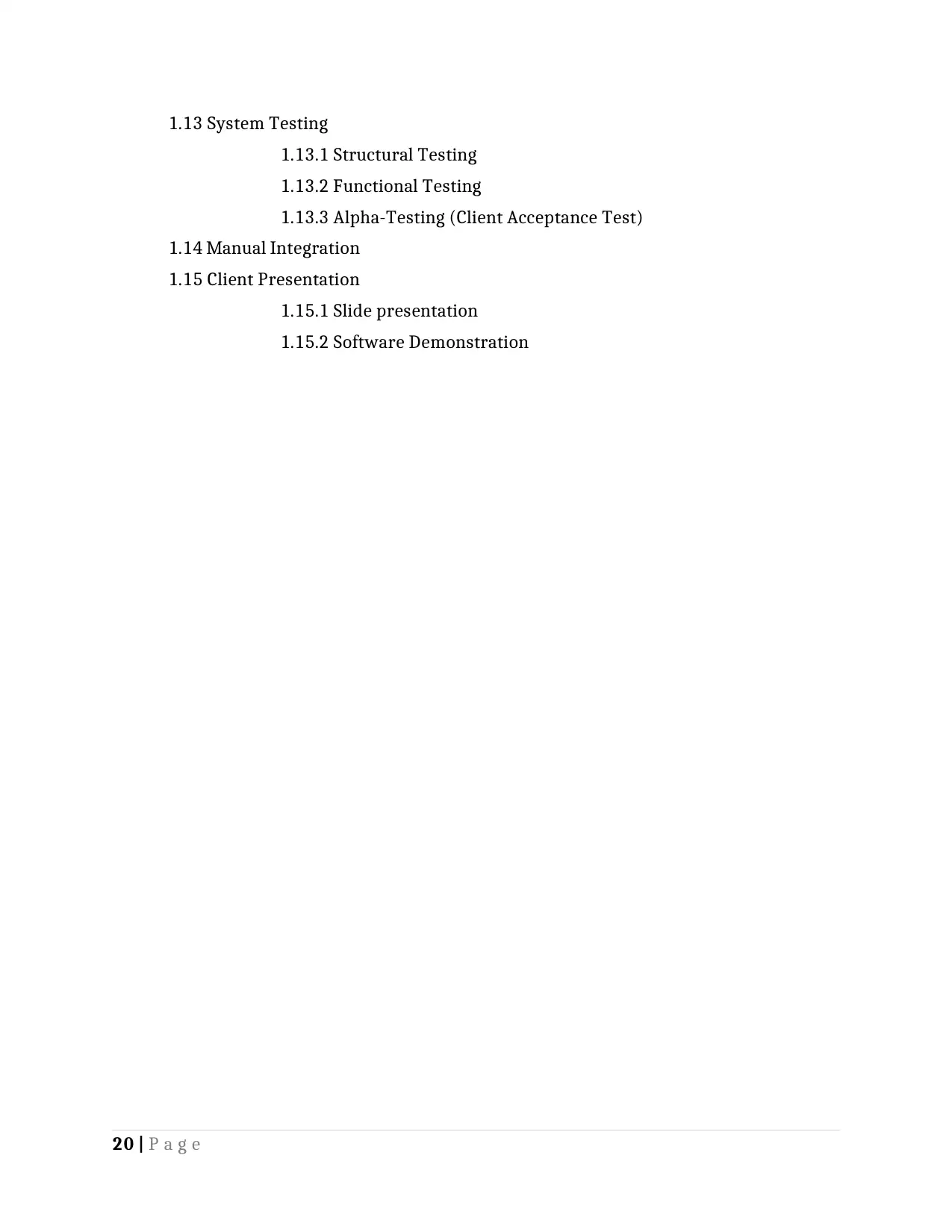
1.13 System Testing
1.13.1 Structural Testing
1.13.2 Functional Testing
1.13.3 Alpha-Testing (Client Acceptance Test)
1.14 Manual Integration
1.15 Client Presentation
1.15.1 Slide presentation
1.15.2 Software Demonstration
20 | P a g e
1.13.1 Structural Testing
1.13.2 Functional Testing
1.13.3 Alpha-Testing (Client Acceptance Test)
1.14 Manual Integration
1.15 Client Presentation
1.15.1 Slide presentation
1.15.2 Software Demonstration
20 | P a g e
1 out of 21
Related Documents
Your All-in-One AI-Powered Toolkit for Academic Success.
+13062052269
info@desklib.com
Available 24*7 on WhatsApp / Email
![[object Object]](/_next/static/media/star-bottom.7253800d.svg)
Unlock your academic potential
© 2024 | Zucol Services PVT LTD | All rights reserved.





